#so many multitudes...
Text
Was anybody going to tell me that the Carl who does Sims 4 guides also did some for Fallout & Skyrim or was I supposed to find that out in Hbomberguy's Fallout: New Vegas video myself??
#carl is my hero tbh#comprehensive sims 4 guide#fallout 3 and 4 guides#no man's sky god of war terraria stardew valley civ5 and skyrim???#who is this man and why does he know so much stuff on those games???#i swear to god 7 minutes in hbomberguy says 'you didn't explore the level because it's fun though. you did it because you followed a guide'#'btw thank you carl'#and my brain immediately went to the guy i know whose name is carl and who makes video game guides#and yep same dude#so many multitudes...#wow i have a ramble tag now
6 notes
·
View notes
Text
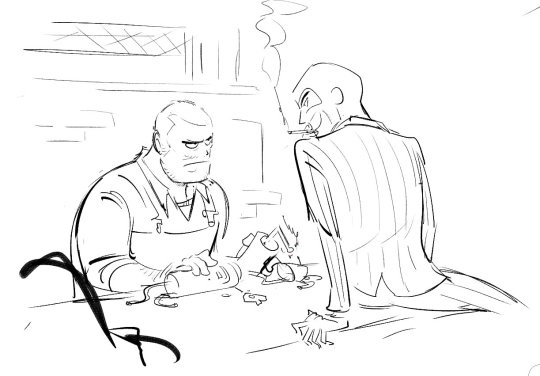





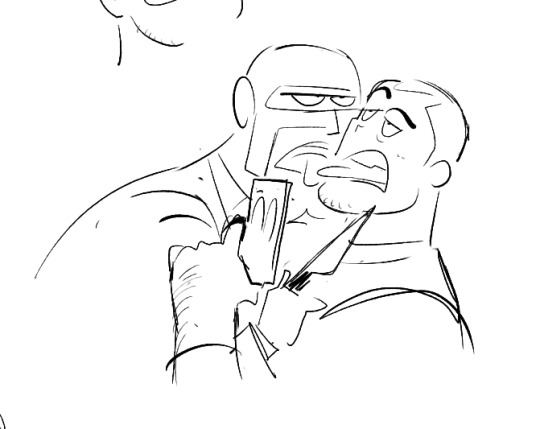
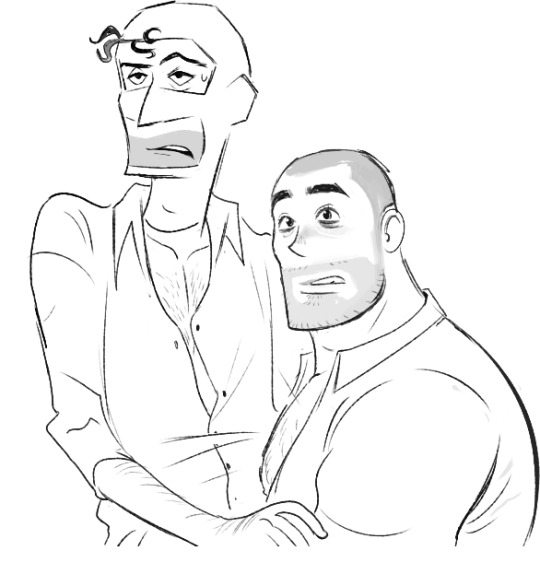
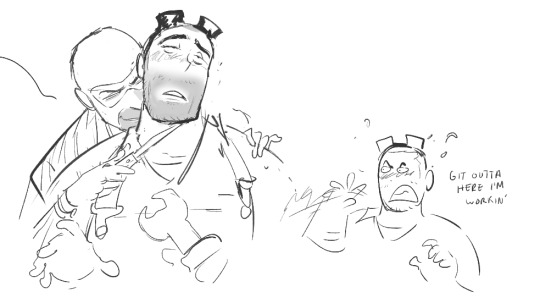
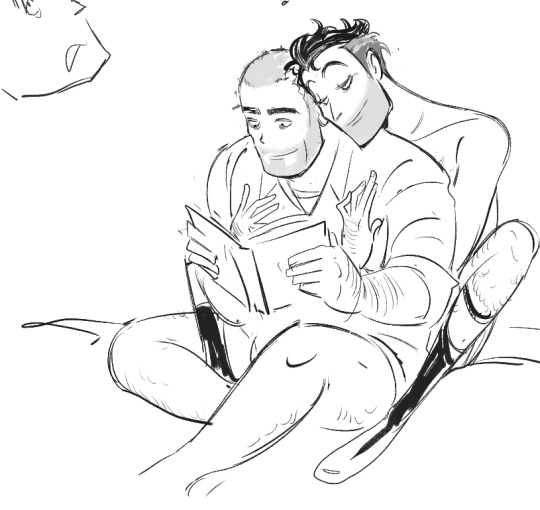
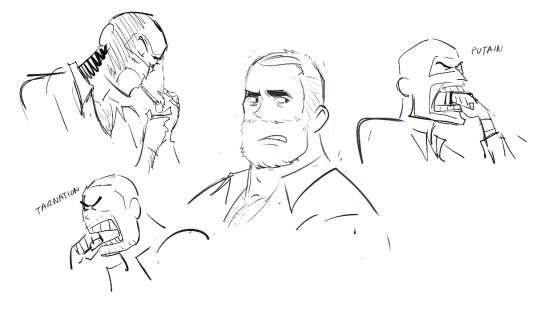


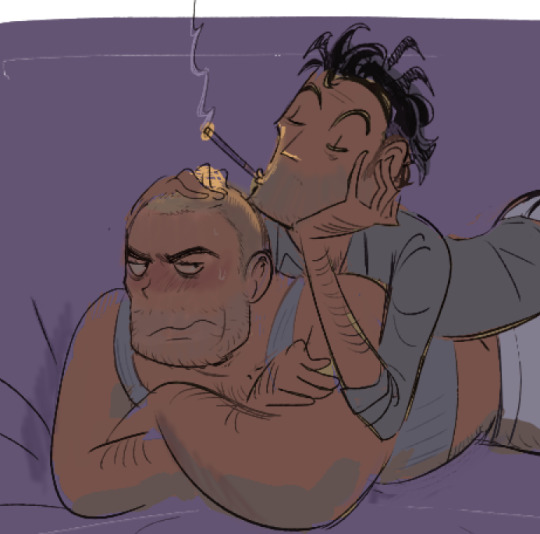
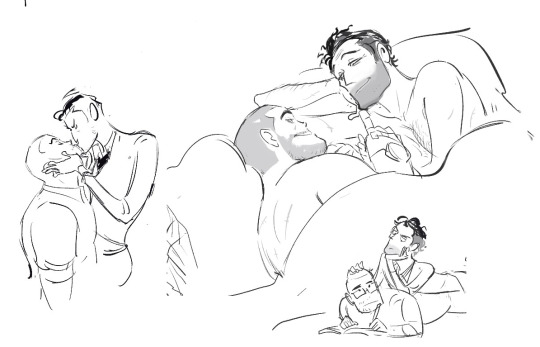
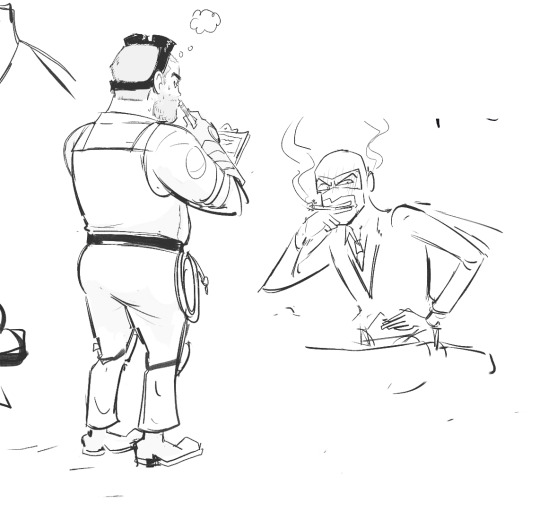
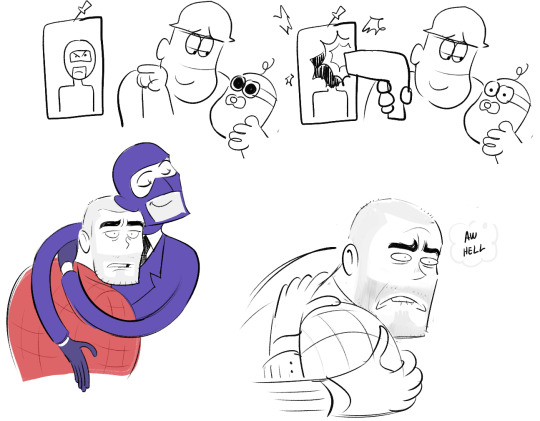
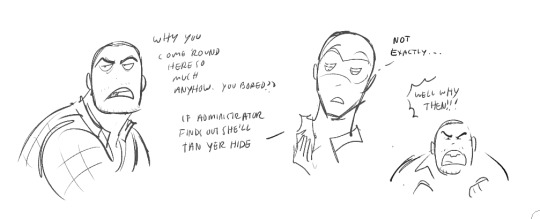
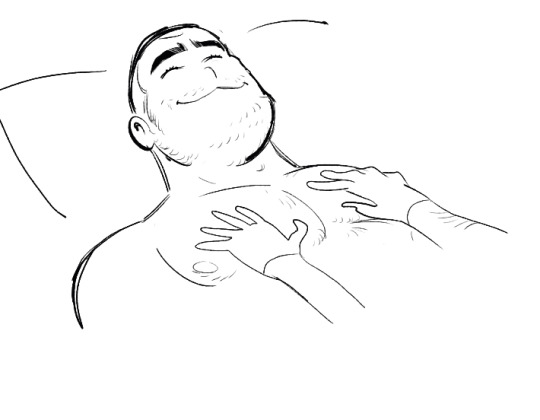



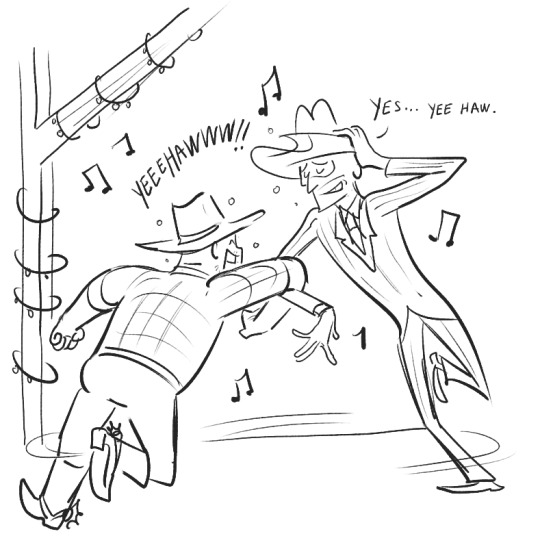
mostly old engiespy doodles, kinda drew most of these for my eyes only but changed me mind today
#holy shit i didnt know u could upload so many pics on tumblr#tf2#tf2 engineer#tf2 spy#team fortress 2#engiespy#i wrote out a bunch of crap but nvm lol. i have many thots abt crossfaction in particular...they are fun 2 me#practical espionage#????#i love happy sunshine eng but i also really love playing w his bitchier side too...all tf2 guys contain multitudes
5K notes
·
View notes
Text

no i am not over how one of the first things kris does of their own accord without our input is to lay down their life for this weird ipad kid they met five hours ago no i am not over "hell yeah i am here to humiliate you fucker" no i am not over "did you miss me? because i missed you!" no i am not over how much not only susie but also kris (and ralsei) genuinely care about their new adopted little cousin guy and the fact that he went from having no friends at all to 3 ride or die bffs who were willing to do what every adult in his life failed to do which is stand up for him i-
#im gonna fucking throw up lancer's relationship with all of the fun gang is literally so important to me#hes gone his whole life surrounded by people but so incredibly alone for a multitude of reasons NONE of which are his fault#every grown ass adult in that castle knew he was suffering but did NOTHING about it#so to see these teenagers (OTHER KIDS) not only take him under their wing and include him whenever possible#but also stand up and say 'NO. no you will NOT get away with that' when his shithead dad abuses him#going so far as to put their own asses on the line for him because they fucking care#and lancer loves them back!!! hes saved the fun gang's asses twice in as many chapters#the first instance being when he did something he's NEVER done before and took up hands against his dad#the affection in his dialogue when he talks about kris and susie and ralsei#calls them all funny nicknames and says that he misses them...#shaking and crying and throwing up and falling down thr stairs and astral projecting#im so so os so so normal about these characters i promise#deltarune
2K notes
·
View notes
Text

Low quality Fionna from last night :)
#adventure time#fionna and cake#I know so many of you are here for vast error but once in a three year event of Kes having an interest in something else#I contain multitudes#my art
465 notes
·
View notes
Text
"Can we let Patroclus kill in 2024" this and "can we let Patroclus fight in 2024" that yall my man's been doing that since 13th cent BC how about we let Patroclus REST in 2024. Take a lil nap, even. Some honk shoo mimimi for Patroclus in 2024 pls
#patroclus#he is TIRED okay#and I am also tired#i've been seeing so many posts about this lately and i'm just........#if you want warrior pat so bad there are SO many adaptations out there for you. so so so many#whatever version of pat you can imagine has been done at some point. don't limit yourself to just one. he contains multitudes#better yet create your own!#let's leave warrior/non-warrior pat discourse in 2023 shall we#tagamemnon
176 notes
·
View notes
Text


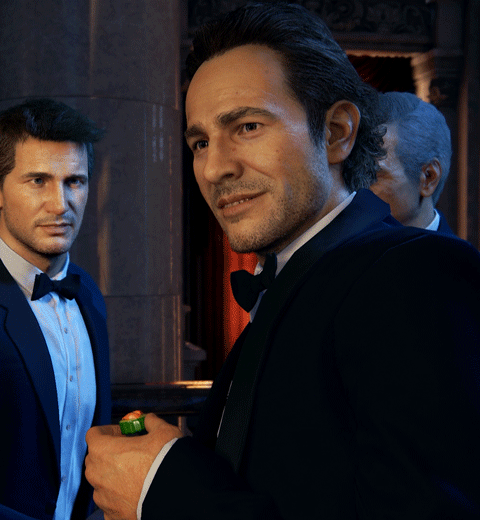
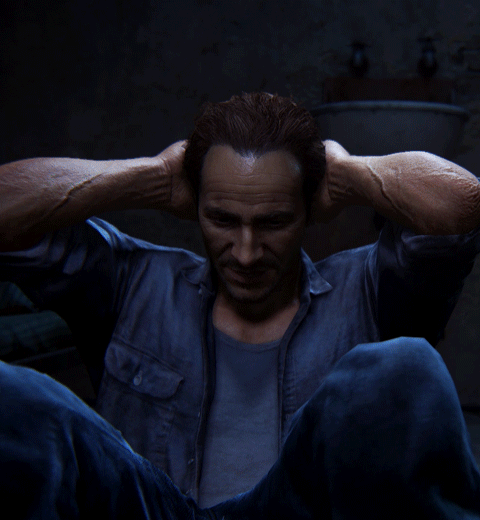

small selection of sam for @malefiicarum's birthday ♡
#I WANT THIS [REDACTED] ON HIS NOSEEEE-#Hes so babygirl. he contains so many multitudes. and all of them are a lil greasy#uncharted#sam drake#samuel drake#gamingedit#vgedit#hil.gif
290 notes
·
View notes
Text
ishmael is a guy who refers to all fasting whether it is christian, muslim, or made-up-by-herman-melville-for-what-herman-melville-thinks-is-the-culture-of-the-south-pacific religions, as 'ramadans'. he is also a guy who moves to a new town with his roommate and they are recommended a particular chowder restaurant and inn, and when the server says, "clam or cod?" he goes "you're going to serve us cold clams for dinner???" and seems one hundred percent serious and not like he's just having a goof. son you were told it was chowder. that's why you came here. and he is also a guy who spends chapter three loudly saying to everybody who will halfway listen that he is absolutely not the type of guy to sleep in bed with a stranger even for convenience's sake and he especially hates it when guys smoke in bed. and then both of those things happen and by chapter five he is saying "there's just something so nice about being curled up in my cozy wee bed with a six foot man throwing his thighs across me . love when he lights his pipe and we lie there smoking and talking til the wee hours this must be exactly like what it s to be a Wife"
#guy who contains so many multitudes it wraps right back around to being Just Some Guy#whale weekly#that said what i'm realizing is that queeqeg is is exacly as weird as him. like he's a Weird Guy also#and they found each other one night when they were both looking for a room and had to double up <3 but nearly killed each other first#because they didnt know another guy was gonna be in the room <3#q
507 notes
·
View notes
Text
There is something so beautifully anvilicious about these quotes;
" I am a bastard too now, just like him. Oh, it would be so sweet, to see him once again. But of course that could never be. Alayne Stone had no brothers, baseborn or otherwise." (AFFC, Alayne II)
"The dream was sweet . . . but Winterfell would never be his to show. It belonged to his brother, the King in the North. He was a Snow, not a Stark. Bastard, oathbreaker, and turncloak . . ." (ASOS, Jon V)
Both Jon and Sansa are yearning for Winterfell and the feelings/memories/family associated -but both are intrinsically restricting themselves based off of their bastard status. The notion of Sansa being the only Stark (and character) to transition from a high-born noble lady to a baseborn bastard cannot be overlooked. (And then of course, the notion of Jon being the only Stark (and character) to transition from baseborn bastard to lord commander, cannot be overlooked.) Jon has risen to the top whilst Sansa has lowered to the bottom.
She (GRRM) makes the comparison to Jon herself, meaning that GRRM makes the comparison himself. this isn't something interpreted by fans - it is right there, explicitly within the text.
Sansa's desire to reunite with Jon is "sweet," it'd be almost like a dream come true. Jon's "dream was sweet" as well. But "Winterfell could never be his" and seeing her brother once again "of course, could never be" (possible).
And then later on in the text, Jon is offered the chance to become Jon Stark, and have Winterfell in name. Thus his decidedly unsubtle desire (that he dismisses as an entirely impossible dream) is fulfilled by Stannis' offer, even though he eventually rejects it in truth "Winterfell belongs to my sister Sansa."
There is also the quote that precedes Jon's "sweet dream," where he fantasises about a beautiful little romance with Ygritte; showing her a flower from the glass gardens, feasting her in the great hall, bathing in the hot pools, and loving beneath the heart tree. This dream is directly connected to Winterfell and is obviously sexually + romantically charged.
So whilst Jon's desire is partially fulfilled (even if he doesn't accept it) can we possibly assume that Sansa's simultaneously unsubtle "that could never be" may also be fulfilled? Since GRRM seems to really be beating us over the head with how 'that could never happen' from Sansa's internal monologue "no one will ever marry me for love" is reiterated multiple times (just you wait sweet one!) and Sansa desiring to reunite with her brother who she has modelled her bastardry after, who is supposedly the only brother left to her, is immediately dismissed by Sansa because she's accepted the fact that she'll never be with her family again, (and that she shall never encounter true love).
The connections only keep connecting!
So to summarise:
Jon & Sansa both have "sweet" dreams/desires that connect to Winterfell/family.
Jon's dream is sexually/romantically charged, involves a red-headed girl, and establishes Jon's suppressed desires as actually romantic.
Both Jon and Sansa are bastards in these contexts.
Both Jon and Sansa woefully dismiss these dreams/desires as impossible as "that could never be" and "it could never be his to show."
Jon's desire however is later offered on a silver platter by Stannis Baratheon, to which he mulls over and states that he "has always wanted it" (to be his). Though he later refuses Stannis' offer on the basis that "Winterfell belongs to Sansa" - twice over he says this.
Jon 'giving' Winterfell to Sansa is in direct contrast to Robb (Sansa's image of an honourably idealistic older brother) flat out rejecting Sansa's claim on the basis of her marriage to Tyrion.
Jon thus establishes himself as the only character who respects and protects Sansa's claim. Who does not abuse or exploit it. (Even though he was given the opportunity for it and it's been his innermost desire since childhood.)
In a way, this further conveys Jon as Sansa's unspoken, subconscious hero who is protecting her interests and instilling all those heroic ideals (such as the Janos Slynt situation) - though she does not realise it and has accepted that "there are no heroes" at all. But Jon is the true hero, hiding in plain sight.
So, whilst Sansa believes there are no heroes, Jon fulfils those ideals. Whilst Sansa believes no one will marry her for love, Jon exists as the embodiment of all the chivalric, romantic ideals that she's so desperately wanted.
Can we now assume that Sansa believing that she will essentially never see Jon again as entirely anvilicious as she will in fact see Jon again?
GEORGE I'M IN YOUR WALLS.
#jonsa#jon x sansa#the fact that I could make a multitude of other connections#like Waymar Royce and the ashford tourney#and Valarr Targaryen#among many many other things#they really are so rich with subtext and linguistic parallels#and people will say they have 0 narrative basis???#HUH???#cause you know for a fact if this was about any other pairing you would not hear the end of it#just ironic lol#anyway Jonnel and Sansa Stark#not going to tell anymore than I already have !
51 notes
·
View notes
Text
thinking of minos referring to v1 as "creature of steel", acknowledging its creation by mankind but how he may possibly view it as almost animalistic in nature now (he cannot judge its actions necessarily and does not blame it really for its imparted instincts, but it must be destroyed as it threatens what little is left of human souls) vs sisyphus calling it "child of man", a phrase used to either emphasize humanity's lesser status toward god/angels or as the title for the one who would usher in the end of days...and simply, purely, "weapon". it is an unthinking harbinger of destruction on any level - it will come, it will destroy, whether as an animal, as a tool, or as an entity. both a force of nature and the result of human hubris...ouughhaaa
#THIS IS NOTHING but i keep thinking about v1 all the time#v1...little force of nature made by human hands!#it's so destructive and yet. it's just one little guy#i think this personal connection is a nice contrast to v1 as part of the masses of machines#BUT how these titles also reinforce with its status as one of many#a pack of animals. a tool like all the others. a leading force that brings a multitude of woes in its wake.#YEA....i love v1.....#cake.txt
81 notes
·
View notes
Text


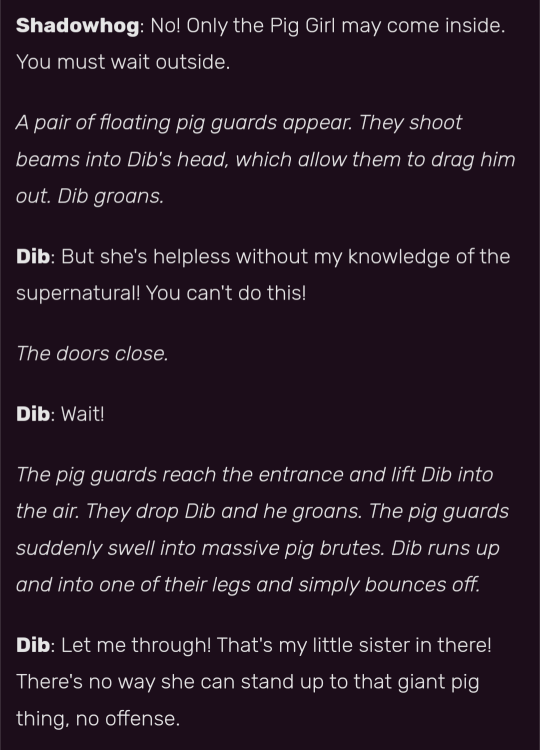
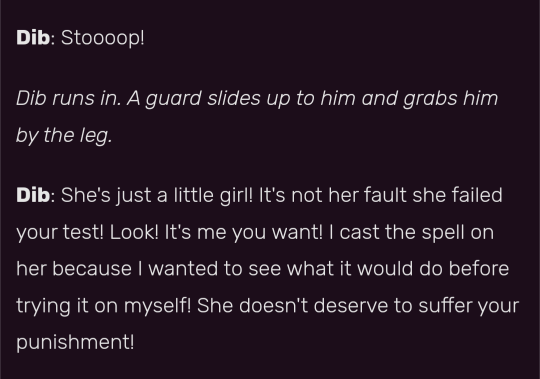
There's something quintessentially very sibling-ish in Dib's ability to simultaneously maintain his perception of Gaz as a walking personification of nightmare capable of turning his life into a living hell AND as the helpless little sister he needs to protect
#invader zim#dib#gaz#membrane family#iz posting#natterings#with a head that big is it any surprise it can contain such multitudes#in all seriousness though i love them and their disaster dynamic#which in many ways feels like one of the most bizarrely realistic dysfunctional sibling dynamics ive ever seen in fiction#which is a fun irony coming from a show as shamelessly absurd as iz#some day ill snap and actually write out the membrane family meta i have in my head#theres so much i could articulate about them if i wasnt too lazy to write it out#ANYWAY#i like contrasting this episode against that one comics issue with gaz cryptid hunting with dib to cover for poisoning him#because it really is nearly the exact same scenario in reverse#and i sort of love the implication that these two will do basically anything to protect each other#but only AFTER theyve intentionally risked their well-being for petty/selfish reasons
25 notes
·
View notes
Text



Warrior Nun | 1.09 | "2 Corinthians 10:4"
#this moment broke my heart because the actress for Lilith does such a good job showing how terrified and lost she is#like just the way her voice quivers as she crumples in on herself and Mary holds her so fiercely because they love each other so much#Lilith and Mary's relationship will never not get to me#so many multitudes within Lilith's character and I love it#the way she's so strong but when she's vulnerable she lets Mary hold her and kiss her head#god just#them 🫶#shotgun mary#sister lilith#warrior nun#gifs are mine#my post
41 notes
·
View notes
Photo
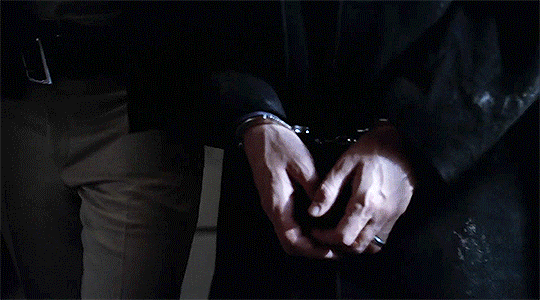

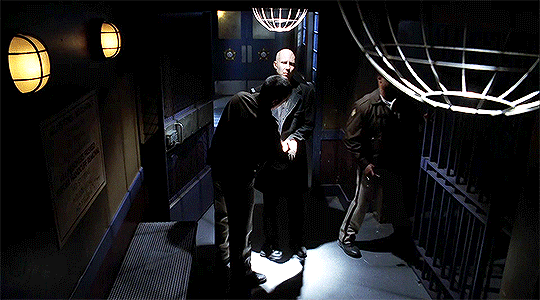

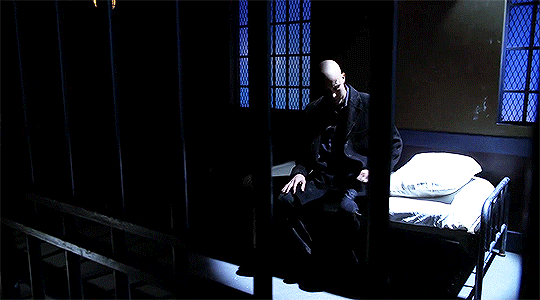

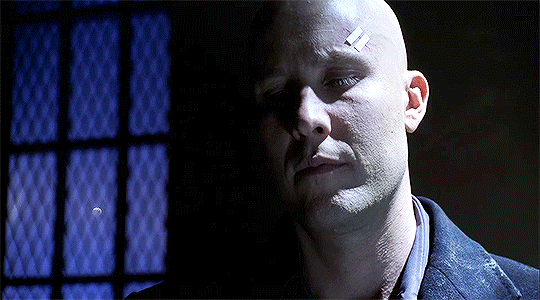
She was the only thing I was living for. I’m sorry for your loss, sir, but right now we need to get you airborne. Police will be here any minute. I’m well aware of that. I’m turning myself in.
— SMALLVILLE, “Bizarro” (7.01)
#it's wild how they were actually doing some interesting character work with lex in the beginning of s7#('I wasn't miraculously saved so I could run away from my demons. I was brought back to face them' etc etc)#only for them to just go 'nah' midway through and toss out all nuance and complexity in favor of a million veritas-related retcons 🙃#not sure if that's because of the writers strike or just this show's usual incompetence but it's a real shame either way#anyway I really liked this plot/scene#lex didn't kill lana but he knows he fucked up in a multitude of other ways in his relationship with her#so he's willing to be punished for a crime he didn't commit bc he doesn't know how else to make up for what he's done#(also him keeping the cute photo of them folded up in his pocket is so heart-achingly sweet I actually can't take it)#smallville#smallvilleedit#svedit#lex luthor#lexana#dcmultiverse#sv 7x01#my gifs#god this gifset has been languishing in my drafts since *checks* FEBRUARY?!?! jfc...#I guess it's a good thing I have so many unposted sets saved since I don't actually have time to make new gifs for the next few months#but still. lol
55 notes
·
View notes
Text
Lore: Baldur's Gate #2
Demographics of the Western Heartlands
Link: Disclaimer regarding D&D "canon" & Index
[tldr: D&D lore is a giant conflicting mess. Larian's lore is also a conflicting mess. There's a lot of lore; I don't know everything. You learn to take what you want and leave the rest]
The City #1 | Demographics | Administration & Government | ??? - WIP
A sort of overview of how people fit into the region. When I say "Baldur's Gate is a human city" I am not overexaggerating.
So: detailing the five main human groups of the region: the elves would rather stay in Evereska, thanks; the half-elves would rather not stay in Evereska: the halflings are cheerfully exploiting the local adventurers; the gnomes mind their own business; the dwarves have a local history that's just the world hitting them with sticks; and for some reason the Hells have it out for the Western Heartlands, and tieflings are resented for being a reminder.
(And the occasional half-orc and dragonborn is there too, I guess.)
-
While the exact percentages may have shifted up or down somewhat over the course of events at the end of the Era of Upheaval and so on, they're still a pretty solid idea of what to expect from the Western Heartlands, and thus Baldur's Gate as the largest population centre (it's also where the most diversity is, being the only major port city for miles).
The breakdown is:
78% Human
7% Elven
4% Half-elven
3% Halfling
2% Gnome
1% Dwarf
1% "Other" [Tiefling, Half-orc, Dragonborn]
-
So 78% of the entire population of the Western Heartlands is human; consisting mostly of five ethnic groups. These groups being defined by their shared inherited cultural norms and genetics across Faerûn.
Chondathan culture heavily shapes Baldur's Gate.
80% of these humans are Tethyrian [melting pot of cultures and genetics, predominantly Calishite and Chondathan by ancestry. By average: brown skin; black hair; blue eyes (northern) or brown eyes (southern). Their primary ancestors were the native people of the lands that became Tethyr and Calmishan who have dark brown skin, but lighter skin can become more commonly seen northwards, where Netherese and Illuskan genetics enter the mix].
In the Western Heartlands - they mostly follow Chondathan cultural norms. They have a history of being colonised and enslaved (largely by Calimshan), value freedom and community above all else; slavery is the pinnacle of evil. They have a strong bardic tradition due to relying on oral lore and song to keep their histories and what remains of their distinct culture alive (the majority of their cultural norms will be determined by the dominant culture they've mixed with). The average Tethyrian is raised to mistrust authorities with more jurisdiction than a city state (kingdoms and empires = bad).
-
10% are Calishite [dark brown skin; black hair; dark brown eyes. Tend to be short. Due to genie ancestry, most genasi are Calishite]. The percentage is probably higher in the 15th century, due to a wave of refugees.
The ancestors of the Calishites were slaves of genies who came to Toril, set up their empires, annoyed the local elves and got wiped off the map and left the humans to inherit their master's empire. Calimshan is one of the oldest human empires still standing, and they're very proud of this fact. They value reputation above all else (personal and family, both highly interconnected) which is basically a form of social currency. Very strict social divides: Class matters, traditionally they're patriarchal and gender roles are strict, marriage is important and the father determines social class (only women may marry "above their station"). In recent history, a return of the ruling djinn and efreeti led to a lot of war and destruction in Calimshan, sending a wave of refugees into the world. Most of those refugees live seperate from the main city in "Little Calimshan" in the Outer City. Said war has recently ended, due to the actions of a Chosen of Ilmater, and many Calishites in Baldur's Gate are considering returning home (especially because there is considerable friction between the refugees and the locals).
Sorcery is a common occurance, and Calishites have a strong arcane and divine tradition.
-
5% are Chondathan ["tawny" brown skin; light brown to black hair; brown or green eyes. Tend to be tall].
Their ancestors started off as warriors, whose many wars led to them destroying an elven city and a retaliatory tidal wave that eventually led them to discover that trade worked better for them (this did not stop them pissing off elves everywhere they went), they did such a good job that they dominated Central Faerûn through mercentile skill, and Chondathan culture (i.e. language, the Thorass alphabet and such) is a major influence pretty much all over Faerûn. Typically Chondathans have adapted quickly and peaceful to the norms and laws of other peoples, and a Baldurian, Cormyrian and a Sembian will not be perfectly interchangable. Still they will often have shared values: Violence is tacky and counterproductive. a reputation for honesty is paramount and breaking your word is taboo. Tend to be cat people, with a strong appreciation for tressyms. They value hard work, industry and admire wealth (which is power and evidence of a good work ethic). Social standing is determined by money and influence. Class divides don't tend to be rigid, and it's generally believed that hard work should open doors. You start work at 12 (apprenticeships) and if you're able bodied you will be shamed for "not pulling your weight". The elderly tend to hang around after retirement and tutor the next generation. They have little in the way of magical traditions, or interest in it.
-
3% are Illuskan [pale skin; blonde, red or black hair; blue or grey eyes. Tend to be very tall].
Rarely found outside of the North (including the Sword Coast North, across the border), most Illuskan cultures are tribes and settlements on the frontiers. They value courage, battle prowess and survival and haven't been as successful in the larger world because they tend to prefer war and raids to trade. Larger civilisation hinders growth and encourages weakness and dependency, and is largely shunned. The rest of the world considers them "no better than orcs" and the Illuskans think the rest of the world are a bunch of cowards unworthy of respect. Not being able to be the warrior hero of some kind of epic tale (or being bold enough to aspire to be) is not necessarily a thing to be ashamed of that you will be mistreated for, but you won't be given any respect past basic courtesy either.
Magic is not infrequent amongst Illuskans, due to Netherese ancestry, but it is mistrusted due to the history of the Arcane Brotherhood of Luskan, who are evil bastards. Religion is eh. Illuskans generally only have uses for gods who serve a practical purpose (so appeasing the gods of fury (such as Auril and Umberlee) and Talos, god of war).
-
1% consists of the Gur [brown skin; thick, straight black hair; dark brown eyes. Tend to be hirsute and short, but "stocky"]
The ancestors of the Gur were Rashemi, a people they still strongly resemble, physically. The modern people feel no kinship with their distant kin though. They're mostly nomads, but some Gur can be found permanently settled in the slums of cities like Baldur's Gate and Elturel, where they're treated as subhuman. Their patron deity is Selûne: protector of travellers and outcasts, and a patron of diviners, which the Gur practice for protection and aid in navigation (as such they also worship Savras, god of truth and fate, patron god of divination). Amongst their own the Gur speak a unique dialect of Rashemi that no outsiders are privy to.
There's not a lot on the Gur, but if they share any cultural norms with the Rashemi, it might be something like this: The Rashemi value personal skill/strength (in whatever form that takes) and achievements, and scorn the concept of inherited (unearned) titles and wealth. They also value the wellbeing of the land itself, to which they show respect. While they don't shun work, they don't live for it either; the youth are often found carousing loudly with their friends, and while the adults are expected to contribute to society, they also enjoy a good time.
Children are subject to tests as they mature, and elders are afforded great respect for their experience and the challenges they have overcome in reaching their age.
Interestingly, Rashemi expats also have a reputation for being "nuisances" outside of Rashemen: many struggle with culture shock, and the stereotype is that they will get drunk and wander around picking fights everywhere (the Rashemar norm of challenging others to help them and you improve comes across as aggression to outsiders).
-
The remaining 1% is a mixture of the many, many, many different humans on Toril. This canonically includes one of Faerûn's only Maztican communities, consisting of the Nexala people living in Baldur's Gate (I think they drew inspiration from the Mexica?) and there appears to include a Kozakuran (Japanese fantasy counterpart) minority. TSR's decision to start creating fantasy world counterparts to real world cultures for "exotic" expansions is... hmm, contentious, and I don't know enough about the real world counterparts to know if I'm handling it well, so I'm not going further into that.
------
7% of the population of the Western Heartlands is elves, making up the largest non-human population of the region.
It's mostly moon elves [fair skin, often seen in literal white hues likened to alabaster and marble, with tinges of blue; white, silver (like the metal, not grey) or black hair; eyes always flecked with gold] and wood elves [copper brown skin, tinged with green; blonde, red, brown or black hair; brown or green eyes. Metallic sheen to hair and skin.] Some sun elves returned to Faerûn in the mid-1300s [gold, bronze or amber skin; blonde, red or black hair; golden brown, green or black eyes. Metallic sheen to hair and skin.]
(both moon elves and sun elves are categorised as "high elves", in BG3 mechanical parlance).
Moon elves are individualistic and have a reputation for flightiness, thrill-seeking and hedonism. Sun elves are conservative, more observant of social hierarchies, have a strong cultural focus on magic (divine and arcane both) and extremely wary of humans due to historical conflict and human expansion into (now lost) elven lands. Wood elves are known for their open mindedness towards non-elves and many hope for elves to live fully amongst the non-elves one day, but due to their nature-oriented spirituality and way of life they rarely venture into human civilisation and are usually highly uncomfortable there.
When compared to the percentages of other demihumans in the area, the elven population seems very high, though that 7% accounts for Evereska, the last major bastion of elven civilisation on Faerûn. Although apparently the elves are trying to rebuild Myth Drannor yet again, and good luck with making that stick.
While elves do make up the largest non-human minority group in Baldur's Gate, the vast majority of that 7% traditionally remains in Evereska and refuses to leave their homeland's borders, and of those that leave it's almost entirely moon elves, who are the most likely to assimilate into human culture. A minority of wood elves might be able to get comfortable in cities. Your average sun elf, to whom preservation of elven culture is a sacred duty given by Corellon him/herself, would be horrified by the concept of assimilating into the N'Quess, and any that aren't are going to be under immense social pressure from their house/clan to come home and conform (especially because there's a chance that their family may view humans as dangerous). That said, the flightiness of youth can generally be forgiven (they'll grow out of it).
Most encountered are young adventurers under 100 years old and semi-nomadic family groups of moon elves who wander between human settlements as their whims (and/or the mercantile work of their clan/house) takes them. Older elves are unlikely to be found in Baldur's Gate in high numbers, as the rapid, demanding pace of the metropolis clashes badly with the "take your time" philosophies and lifespan of elves.
A few families of sun elves also established themselves in the minor human cities of Iriaebor and Berdusk, further South East, after returning from the Retreat.
-
4% of the population is half-elven, almost entirely of moon elven descent, and, on the human side, likely to be of Tethyrian ancestry.
It's likely most are found in human cities, even if they weren't already born there. The noble houses of Evereska have traditionally been extremely xenophobic (even the elven commoner clans were considered beneath them), and the only non-elves permitted entry for most of Evereska's existence have been Harpers: the opportunities for half-elves to be born within the realm have been fewer that otherwise.
Human civilisations also saw an influx of half-elven immigration during the late 14th century - albeit most moved North - when the Spellplague caused Evereska and the Feywild to merge slightly, and an increase in xenophobic attitudes made many feel unwelcome.
-
3% is halfling, almost entirely lightfoot [very, very wide genetic pool. The hin have moved around enough that no features or colouration has become a norm for an entire geographic population.]
Lightfoot halflings - or hin, amongst themselves - are pretty much all over Faerûn, having made themselves comfortable and unobtrusive living alongside humans. They mostly assimilate into human cultures, though there is still a focus on clan and family.
There is a small village in the region called Gullykin, which mostly keeps to itself and profits from its brewery (which also happens to be the temple of Yondalla). They also cheerfully make a side profit off of the frequent adventuring parties who use the village as a rest stop while exploring the nearby ruins (Durlag's Tower and the Firewine Ruins). The locals have no interest in the ruins themselves, considering Firewine particularly cursed, and pride themselves in being as peacefully boring as they possibly can.
-
2% consists of gnomes, almost entirely rock gnomes [brown skin; white hair; no information given on eye colour, although "glittering black" has been used as a descriptor.]
Gnomes prefer to stay well hidden, in secret villages scattered around the world and unseen by outsiders, but a minority are drawn to Baldur's Gate. Rock gnomes split their time and focus between their career (usually craft of some sort, and rock gnome working environments are known for their very relaxed, friendly atmospheres) and partying.
-
1% consists of dwarves, shield dwarves [pale to light brown skin; dark hair; blue eyes] and gold dwarves [light to dark brown skin with a reddish hue; black, grey or brown hair; brown or hazel eyes]. Exact numbers aren't given, but as, historically, the shield dwarves almost went extinct due to wars where the gold dwarven numbers reached such levels of overpopulation in the Great Rift during the Thunder Blessing of 1306 DR that many were forced to migrate in droves, I would assume that it's either, like, a 50/50 split, or the gold dwarven population is the higher one.
Gold dwarves put their success and survival down to adherence to dwarven ways of life and are staunch traditionalists, cleaving to family, clan and faith: Dwarven history being characterised by the loss of homeland after homeland, they are very keen to ensure that their way of life survives. They have a bad history with the various inhabitants of the Underdark (especially drow).
Shield dwarves have been in the area the longest. They have lost many of their homelands in the North to orc invasions and the expansion of humanity in their subsequent weakened state. Those found in the Western Heartlands belong to a subdivision called the Wanderers; dwarves who after the loss of their ancestral homes took to a more nomadic life, making a living as mercenaries and crafters in the settlements of other races. Many may have non-dwarven ancestry, as shield dwarves started intermarrying to bolster their numbers due to wars and an infertility crisis rendering their population dangerously low - non-dwarven ancestry is mostly humans and gnomes, though some hin and elven blood can be found. The same traditions their gold dwarven kin hold to exist in shield dwarven culture, but due to the pressures of survival many traditions are looser or have fallen by the wayside.
The most successful dwarves are presumably the Shattershield clan, who settled in Baldur's Gate at the time of the city's origin and became the Gate's sole non-human Patriar family.
There have been attempts to create new homelands in the Western Heartlands, and all of them met with disaster. The town of Kanaglym, established in 722 DR eventually discovered that they'd accidentally found a portal to the Fugue Plane in the town well. The half-dwarven adventurer Daeros Dragonspear established Dragonspear Castle aboveground, over the town's location in 1255 DR, creating a safe haven for the dwarven people that was also guarded by Daeros' copper dragon companion Halatathlaer, who had a lair nearby. Then a mage, seeking the dwarves' wealth, decided to embark on a complicated plot, of which the most relevant step was opening a portal to Avernus and tricking Daeros to walk into it, and also destroying the castle with an invasion of dragons.
A dwarf by the name of Durlag Trollkiller also established a home for his clan (Durlag's Tower) at some unknown date, and that was later annihilated by an infiltration of doppelgangers and mind flayers.
The Orothiar clan settled in the Cloakwood, however they were forced to abandon their clanhold when a mine wall was accidentally breached: the river flooded their home, and wiped out most of their people, bar a few survivors.
-
1% covers everybody else.
Hobgoblins, gnolls, goblins, kobolds and such will make up the majority of this category; the recently established Yuan-ti kingdom of Najara has also joined this percentage; with a minority of half-orcs (orcs are not really found in the Western Heartlands, the nearest are mountain orcs in the North), and then a smaller handful of planetouched (tieflings, genasi, aasimar (mostly tieflings and genasi)) and dragonborn left over.
While generally not popular anywhere, tieflings are particularly mistrusted in the Western Heartlands. They're associated with the Dragonspear Wars - the first of which took place in 1356 DR - where Waterdeep and Baldur's Gate went to war with the invading forces of Avernus (coming from portals set up in the eponymous Dragonspear Castle).
There was another invasion in 1363 DR.
Then that time Mephistopheles invaded Waterdeep in 1372 with the intention of conquering Toril and turning it into the tenth layer of hell probably didn't help their reputation either.
Nor the fey'ri invasion of Evereska in 1374 DR.
Nor did the Elturel incident...
It's not unlikely that there are a fair few people with dormant infernal blood in their veins, but the tiefling population isn't likely to see much growth, as the birth of a tiefling child to human parents is not infrequently met with panic and infanticide.
There's nothing I can really find on half-orcs, but I would imagine most are of mountain orc and Illuskan heritage, and they or their ancestor/s migrated from the North.
I'd hazard a guess that the entire dragonborn population of Baldur's Gate - possibly the entire region - can be seen in-game. They have no history in the area that I know of.
#idk but this post makes me feel like anxiety vomiting...#fyi WYLL IS THE MOST ACCURATE FR CHARACTER IN THIS GAME FOR A MULTITUDE OF REASONS including his speech patterns#Dude actually *sounds* like he lives here#god that took a while#There were so many sources and I'm concerned I didn't double check enough and aaaaaaaaaaaaa#The good news is that I'm too tired to be yelling now#lore stuff#long post
17 notes
·
View notes
Text
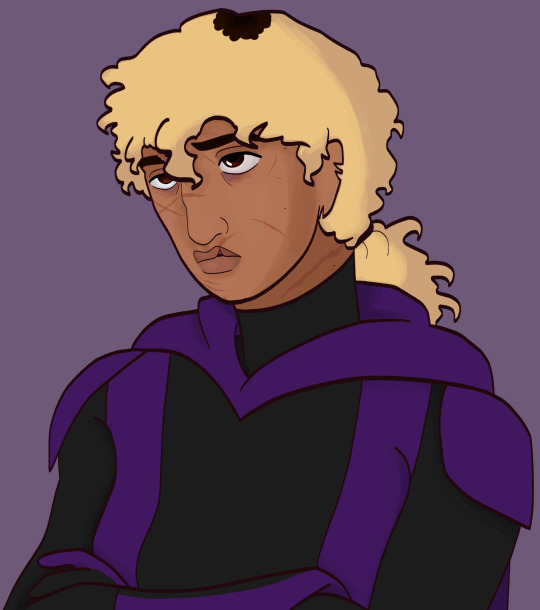

Alexa play Class of 2013 by Mitski.
#I have sooo many thoughts and feelings about them#imagine taking care of your mom your entire life#because she can't/won't do it herself#and you have a set dynamic that doesn't really ever change#only to find that she only changed and got better when you weren't there#I'd go insane actually!!#oh Steph your multitude of parental issues are so charming <3#my art#Steph tag#stephanie brown#the spoiler#batgirl#crystal brown#dc comics
33 notes
·
View notes
Text

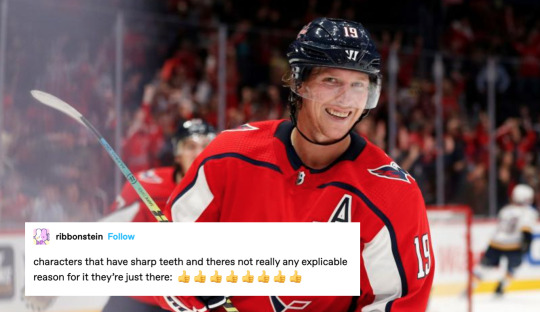










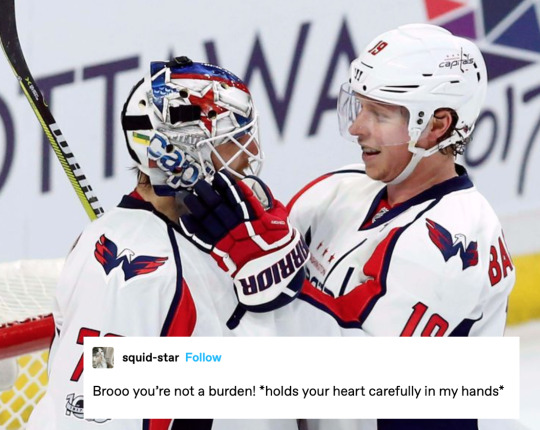



I finally got the files off my old hard drive just for the purpose of finding all my old nicke text post memes
nicke my dearest papà i love you forever <3
#some of you may not agree with all of these characterizations but that's too bad because I'm right#he contains multitudes#I have so many more but these were the best ones#I could post the 819 ones but I don't want to cry TOO hard#nicklas backstrom#my memes#hockey#washington capitals
33 notes
·
View notes
Text
ough the absolute Rarepair i have in my head rn.... it literally has not been done yet
#wait what do you call it when theres three of em#rarethrouple? raretriple? rarepoly? whatever!#im.... chewing on it#Not Rabidly!!! but i am biting it#its not like... something id seriously ship in the Least#a very fun 'suspending my disblief Just Having A Good Time' ship yk yk#its cute i think!#not realistic at All but thats not the point here!!#yk ive been meaning to just make a post of a bunch of random scribbles of my favorite wh pairings#and throuplings. is that a word#bc i am a Multishipper! i enjoy multitudes at once!#ofc i have Preferences and Favorites but that does not mean i dont enjoy others!#just like how i enjoy many different kinds of cake#i will Sample almost all of them!#absolutely unprompted#anyway i gotta sleep uhhhh im gonna think on this one#and maybe scribble a little something in the morn to try and Share My Vision#its so fun.... pure delight with a smidge of angst for Flavor....#ouagshfbsjdnkss the intricacies... adding on facets yes....#ok sleep time im So Tired#i will drift off to dreamland while thinking about this throuple...
42 notes
·
View notes